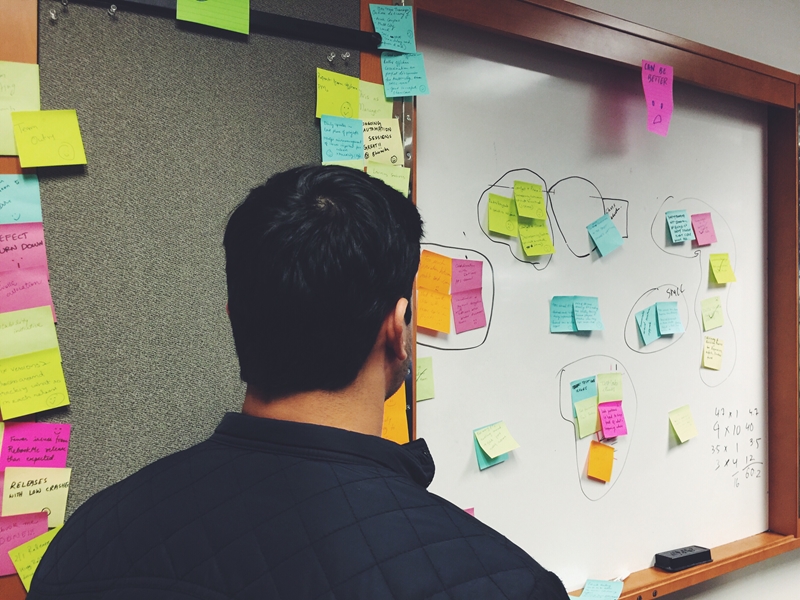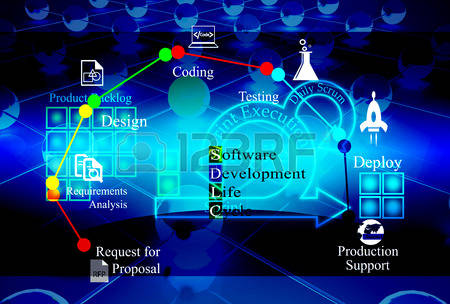An agile framework emphasizes flexibility during the software development process. Agile developers understand that customers’ needs can change quickly and are willing to adjust their designs to accommodate the user.
The traditional approach to software design follows a “waterfall” pattern, in which all the development details are pre-planned before they are executed. This course of action typically takes longer to produce a usable product, requires far more documentation and oversight, and sticks to the customer’s original needs.
In contrast, the agile software development lifecycle allows larger projects to be broken down into easily completed tasks. Creating workable software and adding to its capabilities is emphasized, rather than trying to create the perfect software in a single release. A specialized agile coach will ramp you and your organization up quickly to ensure productivity and efficiencies.

Let’s take a closer look at the agile development lifecycle:
1. Concept. All software begins as an idea or concept and morphs into a full-fledged product. The Concept stage is where preliminary brainstorming takes place. What software does the client and/or market need? What can the software development team produce? Which products should be prioritized?
2. Inception. In this stage, the concepts are brought one step closer to reality by planning out the logistics of a new project. Who will develop this software? What roles will each team member fill? How will funding be secured? What features should be prioritized on the product? Any tools that are required to build the software are also secured during the Inception stage.
3. Construction. Ready, set, go! With all of the tools and team members in place, developers can get busy creating a workable product. If the Inception stage is executed well, then the Construction stage should run fairly smoothly. Agile developers typically work in small groups and use additional frameworks, like Scrum, to complete daily tasks. Although agile development focuses on flexibility, it’s important to have a daily routine to keep team members focused and on schedule. Tackling large projects in bite-sized pieces is the most effective way to get the job done. Within the Construction stage is a lifecycle unto itself, as new features must often go through concept and inception stages. The latest versions are often demonstrated to stakeholders in order to secure funding for continuing development.
4. Release. Once a viable product has been completed, it goes through a testing phase to weed out any bugs and to address common errors before it is released to the end user.
5. Production. Whether the software was custom-built for a single enterprise or is available to the general public for purchase, ongoing technical support is required. This is referred to as the Production phase.

6. Retirement. When software is ready to be replaced by a new version or by new software altogether, it must be “retired.” There is a lengthy process that must occur to successfully transition an enterprise to new software without disrupting daily business operations. But even with software available to the general public, there can be a reason to retire it. For example, when new versions are available, support for older versions of the same software is typically phased out.
Many Short Lifecycles Versus One Long Lifecycle
When following an agile development framework, keep in mind that the goal should be to have many short lifecycles versus one long, drawn-out lifecycle. Aim to improve and add to the original software with each new release rather than trying to roll out a full-feature product in a single release. By the time such a product would finally hit the market, the features may not be appealing to the target audience anyway!
However, it helps to plan out a full product in the concept stage in order to set a clear end goal and road map. Be sure to revisit the concept stage often in order to reevaluate the end user’s needs and to refine the features that will be developed in the latest lifecycle.

Agile development is not a free-for-all where developers design and create products spur-of-the-moment. Planning and logistics are still required to get the job done, and following the agile software development lifecycle is one way to stay on course. Still, there are variations of this lifecycle that still fit within an agile framework. The key is to find a method that works well for your development team while simultaneously allowing you to easily meet the ever-changing needs of the end user.
